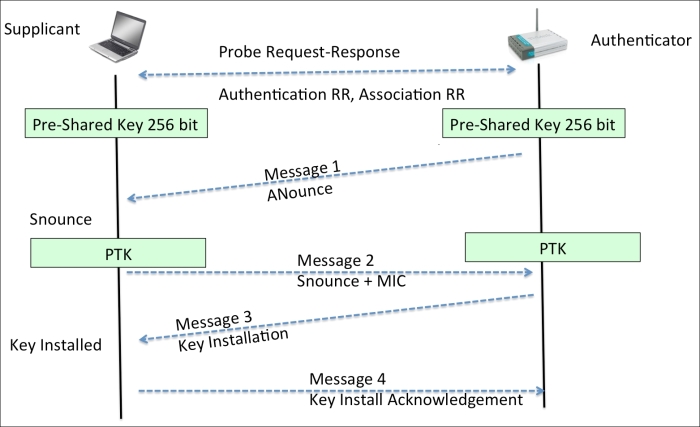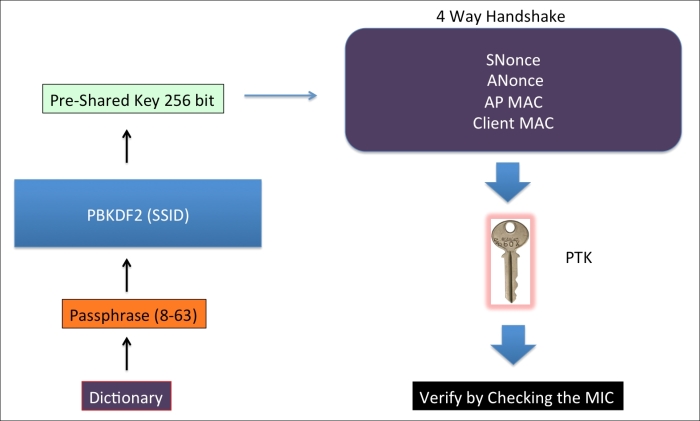WPA (or WPA v1 as it is referred to sometimes) primarily uses the TKIP encryption algorithm. TKIP was aimed at improving WEP, without requiring completely new hardware to run it. WPA2 in contrast mandatorily uses the AES-CCMP algorithm for encryption, which is much more powerful and robust than TKIP.
Both WPA and WPA2 allow either EAP-based authentication, using RADIUS servers (Enterprise) or a Pre-Shared key (PSK) (personal)-based authentication schema.
WPA/WPA2 PSK is vulnerable to a dictionary attack. The inputs required for this attack are the four-way WPA handshake between client and access point, and a wordlist that contains common passphrases. Then, using tools such as Aircrack-ng, we can try to crack the WPA/WPA2 PSK passphrase.
An illustration of the four-way handshake is shown in the following screenshot:

The way WPA/WPA2 PSK works is that it derives the per-session key, called the Pairwise Transient Key (PTK), using the Pre-Shared Key and five other parameters—SSID of Network, Authenticator Nounce (ANounce), Supplicant Nounce (SNounce), Authenticator MAC address (Access Point MAC), and Suppliant MAC address (Wi-Fi Client MAC). This key is then used to encrypt all data between the access point and client.
An attacker who is eavesdropping on this entire conversation by sniffing the air can get all five parameters mentioned in the previous paragraph. The only thing he does not have is the Pre-Shared Key. So, how is the Pre-Shared Key created? It is derived by using the WPA-PSK passphrase supplied by the user, along with the SSID. The combination of both of these is sent through the Password-Based Key Derivation Function (PBKDF2), which outputs the 256-bit shared key.
In a typical WPA/WPA2 PSK dictionary attack, the attacker would use a large dictionary of possible passphrases with the attack tool. The tool would derive the 256-bit Pre-Shared key from each of the passphrases and use it with the other parameters, described earlier, to create the PTK. The PTK will be used to verify the Message Integrity Check (MIC) in one of the handshake packets. If it matches, then the guessed passphrase from the dictionary was correct; if not, it was incorrect.
Eventually, if the authorized network passphrase exists in the dictionary, it will be identified. This is exactly how WPA/WPA2 PSK cracking works! The following figure illustrates the steps involved:

In the next exercise, we will take a look at how to crack a WPA PSK wireless network. The exact same steps will be involved in cracking a WPA2-PSK network using CCMP(AES) as well.
